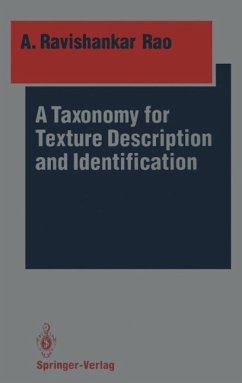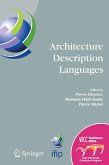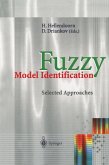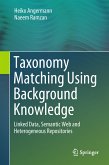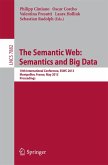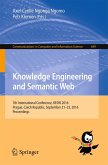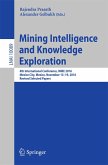A. Ravishankar Rao
A Taxonomy for Texture Description and Identification (eBook, PDF)
40,95 €
40,95 €
inkl. MwSt.
Sofort per Download lieferbar

20 °P sammeln
40,95 €
Als Download kaufen

40,95 €
inkl. MwSt.
Sofort per Download lieferbar

20 °P sammeln
Jetzt verschenken
Alle Infos zum eBook verschenken
40,95 €
inkl. MwSt.
Sofort per Download lieferbar
Alle Infos zum eBook verschenken

20 °P sammeln
A. Ravishankar Rao
A Taxonomy for Texture Description and Identification (eBook, PDF)
- Format: PDF
- Merkliste
- Auf die Merkliste
- Bewerten Bewerten
- Teilen
- Produkt teilen
- Produkterinnerung
- Produkterinnerung

Bitte loggen Sie sich zunächst in Ihr Kundenkonto ein oder registrieren Sie sich bei
bücher.de, um das eBook-Abo tolino select nutzen zu können.
Hier können Sie sich einloggen
Hier können Sie sich einloggen
Sie sind bereits eingeloggt. Klicken Sie auf 2. tolino select Abo, um fortzufahren.

Bitte loggen Sie sich zunächst in Ihr Kundenkonto ein oder registrieren Sie sich bei bücher.de, um das eBook-Abo tolino select nutzen zu können.
This book solves the signal to symbol transformation problem for texture, an important issue in computer vision. The algorithms developed here have been applied to a wide variety of textured images.
- Geräte: PC
- ohne Kopierschutz
- eBook Hilfe
- Größe: 20.44MB
Andere Kunden interessierten sich auch für
![Architecture Description Languages (eBook, PDF) Architecture Description Languages (eBook, PDF)]() Architecture Description Languages (eBook, PDF)72,95 €
Architecture Description Languages (eBook, PDF)72,95 €![Fuzzy Model Identification (eBook, PDF) Fuzzy Model Identification (eBook, PDF)]() Fuzzy Model Identification (eBook, PDF)40,95 €
Fuzzy Model Identification (eBook, PDF)40,95 €![Taxonomy Matching Using Background Knowledge (eBook, PDF) Taxonomy Matching Using Background Knowledge (eBook, PDF)]() Heiko AngermannTaxonomy Matching Using Background Knowledge (eBook, PDF)28,95 €
Heiko AngermannTaxonomy Matching Using Background Knowledge (eBook, PDF)28,95 €![The Semantic Web: Semantics and Big Data (eBook, PDF) The Semantic Web: Semantics and Big Data (eBook, PDF)]() The Semantic Web: Semantics and Big Data (eBook, PDF)40,95 €
The Semantic Web: Semantics and Big Data (eBook, PDF)40,95 €![Automatic Processing of Natural-Language Electronic Texts with NooJ (eBook, PDF) Automatic Processing of Natural-Language Electronic Texts with NooJ (eBook, PDF)]() Automatic Processing of Natural-Language Electronic Texts with NooJ (eBook, PDF)40,95 €
Automatic Processing of Natural-Language Electronic Texts with NooJ (eBook, PDF)40,95 €![Knowledge Engineering and Semantic Web (eBook, PDF) Knowledge Engineering and Semantic Web (eBook, PDF)]() Knowledge Engineering and Semantic Web (eBook, PDF)40,95 €
Knowledge Engineering and Semantic Web (eBook, PDF)40,95 €![Mining Intelligence and Knowledge Exploration (eBook, PDF) Mining Intelligence and Knowledge Exploration (eBook, PDF)]() Mining Intelligence and Knowledge Exploration (eBook, PDF)40,95 €
Mining Intelligence and Knowledge Exploration (eBook, PDF)40,95 €-
-
-
This book solves the signal to symbol transformation problem for texture, an important issue in computer vision. The algorithms developed here have been applied to a wide variety of textured images.
Dieser Download kann aus rechtlichen Gründen nur mit Rechnungsadresse in A, B, BG, CY, CZ, D, DK, EW, E, FIN, F, GR, HR, H, IRL, I, LT, L, LR, M, NL, PL, P, R, S, SLO, SK ausgeliefert werden.
Produktdetails
- Produktdetails
- Verlag: Springer US
- Seitenzahl: 198
- Erscheinungstermin: 6. Dezember 2012
- Englisch
- ISBN-13: 9781461397779
- Artikelnr.: 43986933
- Verlag: Springer US
- Seitenzahl: 198
- Erscheinungstermin: 6. Dezember 2012
- Englisch
- ISBN-13: 9781461397779
- Artikelnr.: 43986933
- Herstellerkennzeichnung Die Herstellerinformationen sind derzeit nicht verfügbar.
1 Introduction.- 1.1 Scope of the book.- 1.2 Importance of texture.- 1.3 Potential applications of this research.- 1.4 Issues in automated process control involving computer vision.- 1.5 A taxonomy for texture.- 1.6 Outline.- 2 Computing oriented texture fields.- 2.1 Introduction.- 2.2 Background.- 2.3 Oriented Texture Fields.- 2.4 Experimental Methods.- 2.5 Experimental Results.- 2.6 Analyzing texture at different scales.- 2.7 Processing of the intrinsic images.- 2.8 Conclusions.- 3 The analysis of oriented textures through phase portraits.- 3.1 Introduction.- 3.2 Background.- 3.3 Geometric theory of differential equations.- 3.4 Experimental Methods.- 3.5 Experimental Results.- 3.6 Experiments with noise addition.- 3.7 A related model from fluid flow analysis.- 3.8 Discussion.- 3.9 Conclusion.- 4 Analyzing strongly ordered textures.- 4.1 Introduction.- 4.2 Extraction of primitives.- 4.3 Extracting structure from primitives.- 4.4 Models for strongly ordered textures.- 4.5 Symbolic descriptions: models from petrography.- 4.6 Frieze groups and wallpaper groups.- 4.7 Implications for computer vision.- 4.8 Summary.- 5 Disordered textures.- 5.1 Statistical measures for disordered textures.- 5.2 Describing disordered textures by means of the fractal dimension.- 5.3 Computing the fractal dimension.- 5.4 Experimental Results.- 5.5 Conclusion.- 6 Compositional textures.- 6.1 Introduction.- 6.2 Primitive textures.- 6.3 A Parametrized symbol set.- 6.4 Three types of composition.- 6.5 Linear combination (transparent overlap).- 6.6 Functional composition.- 6.7 Opaque overlap.- 6.8 Definition of texture.- 6.9 A complete taxonomy for texture.- 6.10 Implementing the taxonomy.- 6.11 Conclusion.- 7 Conclusion.- 7.1 Summary of results.- 7.2 Contributions.- 7.3 Future Work.- B Region Refinement.- C Preparation of the manuscript.- Permissions.
1 Introduction.- 1.1 Scope of the book.- 1.2 Importance of texture.- 1.3 Potential applications of this research.- 1.4 Issues in automated process control involving computer vision.- 1.5 A taxonomy for texture.- 1.6 Outline.- 2 Computing oriented texture fields.- 2.1 Introduction.- 2.2 Background.- 2.3 Oriented Texture Fields.- 2.4 Experimental Methods.- 2.5 Experimental Results.- 2.6 Analyzing texture at different scales.- 2.7 Processing of the intrinsic images.- 2.8 Conclusions.- 3 The analysis of oriented textures through phase portraits.- 3.1 Introduction.- 3.2 Background.- 3.3 Geometric theory of differential equations.- 3.4 Experimental Methods.- 3.5 Experimental Results.- 3.6 Experiments with noise addition.- 3.7 A related model from fluid flow analysis.- 3.8 Discussion.- 3.9 Conclusion.- 4 Analyzing strongly ordered textures.- 4.1 Introduction.- 4.2 Extraction of primitives.- 4.3 Extracting structure from primitives.- 4.4 Models for strongly ordered textures.- 4.5 Symbolic descriptions: models from petrography.- 4.6 Frieze groups and wallpaper groups.- 4.7 Implications for computer vision.- 4.8 Summary.- 5 Disordered textures.- 5.1 Statistical measures for disordered textures.- 5.2 Describing disordered textures by means of the fractal dimension.- 5.3 Computing the fractal dimension.- 5.4 Experimental Results.- 5.5 Conclusion.- 6 Compositional textures.- 6.1 Introduction.- 6.2 Primitive textures.- 6.3 A Parametrized symbol set.- 6.4 Three types of composition.- 6.5 Linear combination (transparent overlap).- 6.6 Functional composition.- 6.7 Opaque overlap.- 6.8 Definition of texture.- 6.9 A complete taxonomy for texture.- 6.10 Implementing the taxonomy.- 6.11 Conclusion.- 7 Conclusion.- 7.1 Summary of results.- 7.2 Contributions.- 7.3 Future Work.- B Region Refinement.- C Preparation of the manuscript.- Permissions.
